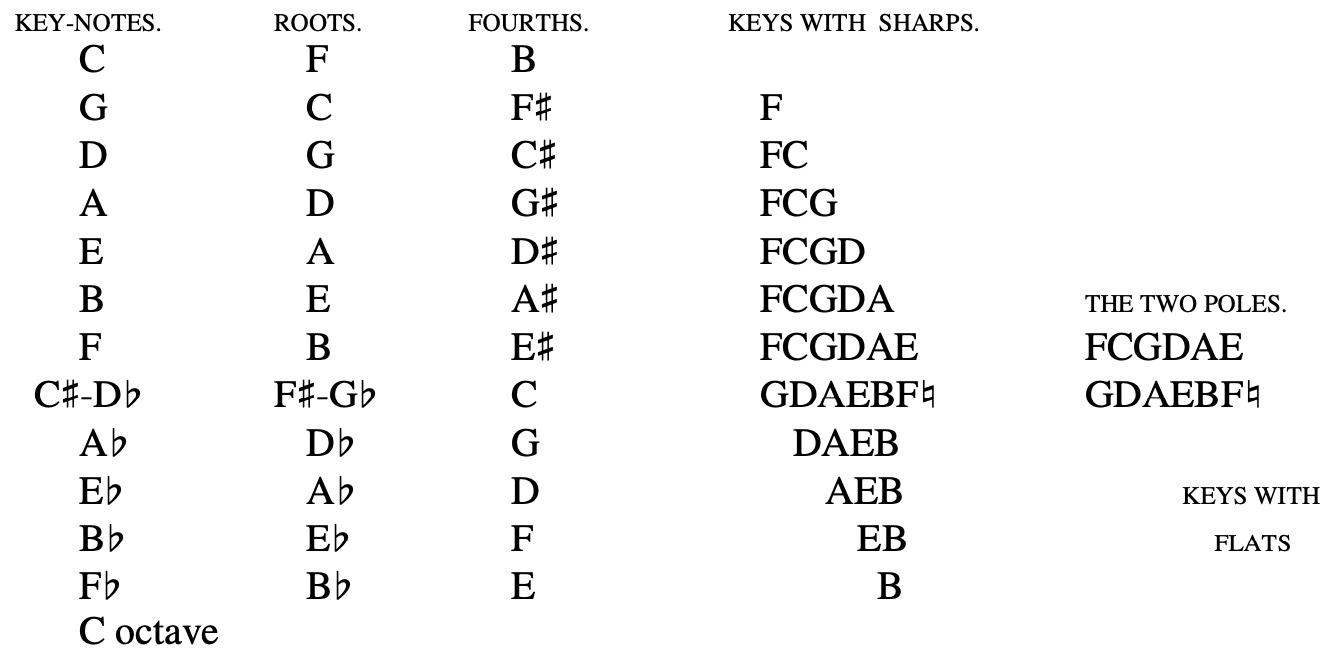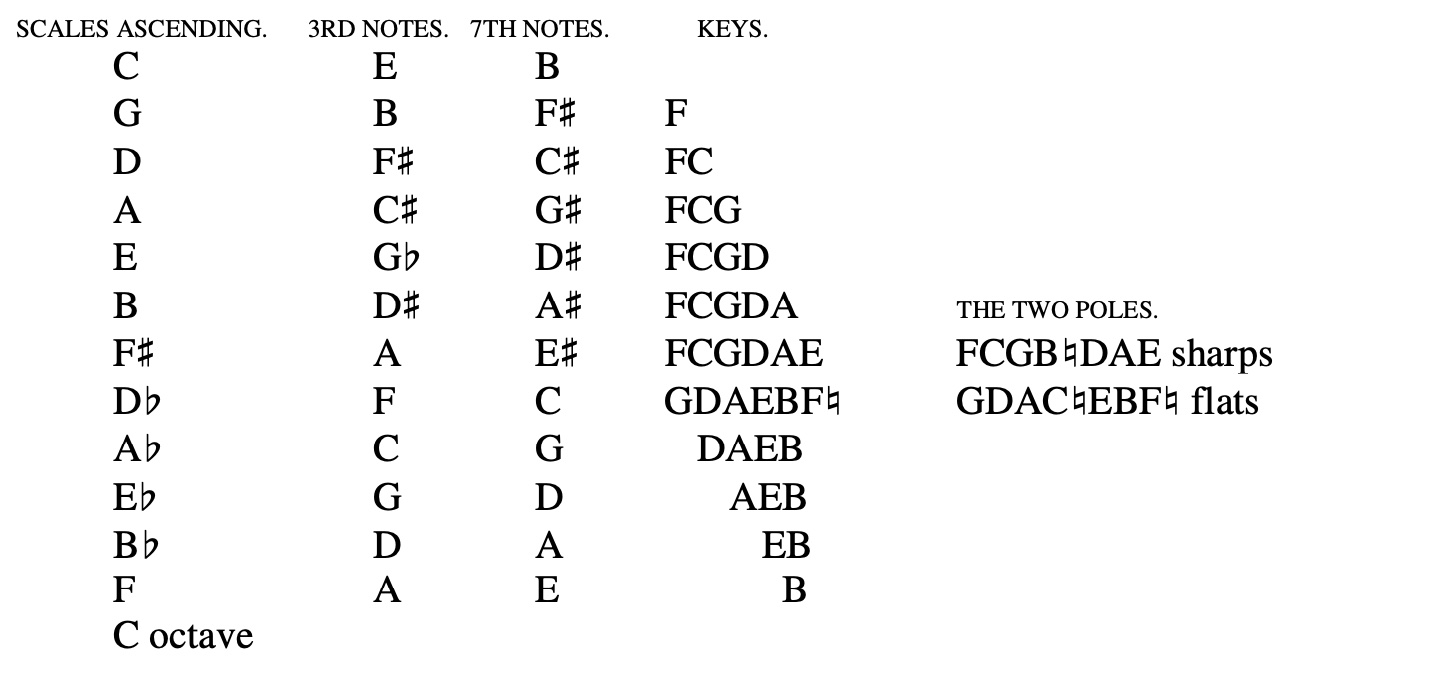Ramsay
The two notes required for the scale of
E minor are the F# of G, and the D of C major;
for B minor, the C# of D, and the A of G major;
for F# minor, the G# of A, and the E of D major;
for C# minor, the D# of E, and the B of A major;
for G# minor, the A# of B, and the F# of E major;
for D# minor, the E# of F#, and the C# of B major. [Scientific Basis and Build of Music, page 90]
In the festoons of ellipses the signatures are given in the usual conventional way, the major F having one flat and minor E having one sharp. The major and minor keys start from these respective points, and each successive semitone is made a new keynote of a major and a minor respectively; and each ellipse in the festoons having the key shown in its two forms; for example, in the major F, one flat, or E#, eleven sharps; in the minor E, one sharp, or F?, eleven flats. Thus is seen all the various ways that notes may be named. The four minor thirds which divide the octave may be followed from an ellipse by the curved lines on which the ellipses are hung; and these four always constitute a chromatic chord. [Scientific Basis and Build of Music, page 115]
Hughes
The key-note C sounding from within itself its six tones to and fro in trinities, the tones written as notes in musical clef
—The trinities hereafter termed primaries and secondaries
—The seven of each of the twelve key notes developing their tones
—The order in which the tones meet, avoiding consecutive fifths
—Dissonance is not opposition or separation
—The use of the chasms and double tones is seen
—The isolated fourths sound the twelve notes
—Each double tone developes only one perfect major harmony, with the exception of F#-G?; F# as the key-tone sounds F? as E#, and G? as the key-tone sounds B? as C?
—The primaries of the twelve key-notes are shown to sound the same tones as the secondaries of each third harmony below, but in a different order
—All harmonies are linked into each other, . 23 [Harmonies of Tones and Colours, Table of Contents2 - Harmonies]
whether veering round, or advancing and retreating in musical clef. I next tried the major keys which develope flats, and I thought that G? would develope a perfect harmony, but found that it must be F#, and that in this one harmony E# must be used in place of F?; on reference, I found that thus the twelve keys developed correctly in succession, the thirteenth being the octave, or first of a higher series. [Harmonies of Tones and Colours, Dr. Gauntletts Remarks1, page 13]
THE five circles represent a musical clef on which the twelve notes of a keyed instrument are written. Six of the notes are shown to be double, i.e., sounding two tones, eighteen in all, including E#, which is only employed in the harmony of F#, all others being only higher or lower repetitions. [Harmonies of Tones and Colours, Diagram I - The Eighteen Tones of Keyed Instruments, page 22a]
We here trace the twelve harmonies developing in succession. Notice how exactly they all agree in their mode of development; also the use of the chasms between E and F, B and C. Remark also the beautiful results from the working of the double tones, especially C#-D?, and E#-F?, causing the seven tones of each harmony, when ascending, to rise one tone, and, descending, to reverse this movement. F#-G? is the only double tone which acts as F# when a key-tone, and G? when the root of D?. The root of each harmony is the sixth and highest tone in each succeeding harmony, rising one octave; when it is a double tone, it sounds according to the necessity of the harmony. The intermediate tones are here coloured, showing gradual modulation. The isolated fourths (sounding sevenths) were the previously developed key-tones; these also alter when they are double tones, according to the necessity of the harmony. Beginning with B, the isolated fourth in the harmony of C, the tones sound the twelve notes of a keyed instrument, E# being F?, and the double tones, some flats, some sharps. [Harmonies of Tones and Colours, Combinations of dissonance, rests, page 24]
The only exception is the double tone F#-G?, which is a curious study. F# as a harmony takes the double tones as sharps, and F? is E#. G? is also a harmony sounding the same tones, by taking the double tones as flats, and B? as C?. F# therefore takes the imperfect tone of E#, and G? the imperfect tone of C?. (See here the harmony of G? in musical clef.) [Harmonies of Tones and Colours, Combinations of dissonance, rests, page 24]
ON a keyed instrument only twelve are major key-notes, but as the double tones C#-D? and F#-G? are roots, there are fourteen different chords. The fourteen that are roots are written in musical clef. As an example of the major chords in the different keys, we may examine those in the key of C. A major fifth includes five out of the seven of its key; with the third or central note it is the threefold chord, or fourfold when the octave note is added. Including the silent key-notes, a threefold chord embraces eight, or, counting the double tones, not including E#, eleven. The first and second chords of the seven of the harmony are perfect major chords in the key of C; the central note of the third chord, being #C-?D, is a discord. The first pair of fifths in the scale, with its central note, is a chord of the key; if we include the octave, the last pair of fifths, with its central note, is the same chord an octave higher than the lowest chord of the seven. Of the chords written in musical clef of the twelve keys, the octave chord is only written to C, the seven of each having two chords and the scale one, thirty-six in all, or forty-eight if the octave chords are added. Notice how the chords of each seven and the chord of its scale are altered. [Harmonies of Tones and Colours, Diagram V - The Chords of the Twelve Major Keys, page 27a]


ALTHOUGH only twelve notes of a keyed instrument develope perfect minor harmonics, there are fifteen different chords, the double tones D#-E?, E#-F?, A#-B? all sounding as roots. The fifteen roots are written in musical clef. A major and a minor fifth embrace the same number of key-notes, but the division into threefold chords is different. In counting the twelve, a major fifth has four below the third note of its harmony, and three above it; a minor fifth has three below the third note of its harmony, and four above it. A major seventh includes twelve key-notes, a minor seventh only eleven. As an example of the minor chords in the different keys, we may first examine those in the key of A, written in musical clef. The seven of its harmony have two threefold chords, and two of its ascending scale. If we include the octave note, the highest chord of the descending scale is a repetition (sounding an octave higher) of the lowest chord of the seven in its harmony, and the second chord of the descending scale is a repetition of the first chord of its ascending scale. These two repetition chords are only written to the key of A: the chords of the other eleven keys will all be found exactly to agree with those of A in their mode of development. We may again remark on the beautiful effect which would result if the colours of the minor chords could be seen, with the tones, as they develope. [Harmonies of Tones and Colours, Diagram XII - The Chords of the Twelve Minor Keys, page 37a]
